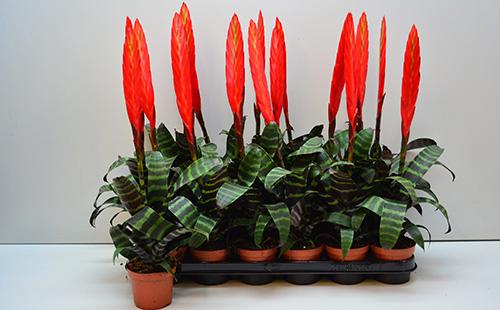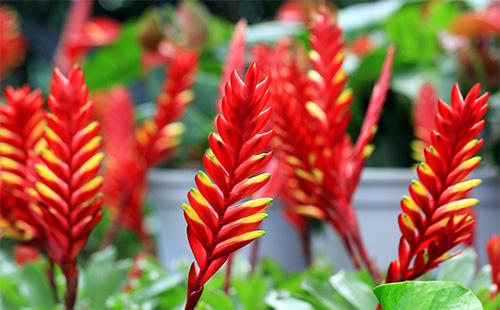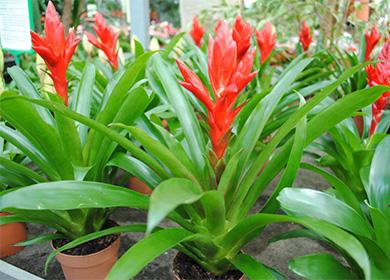The content of the article
It is not difficult to understand why vriesia is valued by gardeners. This flower has absorbed all the best from flowering and decorative-deciduous plants. Its leaves are painted with a beautiful pattern, and bright bracts enliven the interior.
Appearance and features
Vriesia is a perennial evergreen epiphytic plant. Depending on the species, the height varies between 40–70 cm. The leaves are belt-shaped, with a sharp end and smooth edges. The surface is glossy, solid color or with an interesting marble pattern. A rosette is formed from the leaves, resembling a funnel in the form.
Inflorescence is a flat spike. Peduncle tall, erect. The flowers are small, surrounded by bracts of various bright colors. Dominated by red, terracotta and yellow gamma. For the xiphoid shape and the bright colors of vriesia they gave the nickname of the fiery sword.
It blooms for a long time - more than a month. The main outlet in most varieties of vriesia dies after flowering, leaving behind children. The dead plant is cleaned, the children are left in the same pot or planted.
Indoor Varieties
About 250 species are known in the wild. More than half of them get along well in apartments. The most common are seven varieties.
- Astrid. A distinctive feature is a very long flowering - up to four months. It produces five peduncles up to a meter long. Inflorescences are yellow or red. Leaves a light shade, with a smooth surface.
- Mix Peduncles high, characteristic branching of inflorescences. They harmoniously combine yellow and red shades. Bracts are scaly, leaves are strong, evenly colored.
- Silent. A distinctive feature is a thin bract with a sharp keel at the top and a yellow or green border. The leaves are saturated green, bend in the form of an arc. Peduncle length - up to half a meter.
- Royal. Very large, beautiful variety. A distinctive feature is the large leaves of a gray-green hue. Panicled inflorescence: yellow-white flowers, pink bracts.
- Perforated. It stands out not only for its beautiful flowering, but also for unusual leaves. Their coloring is light, the surface is decorated with longitudinal and transverse dark stripes, veins. A reddish-brown fringe stands out at the tip of the sheet. Vriesia blooms in yellow with greenish spotted bracts. The inflorescence characteristic of the species is spike-shaped.
- Sanders. The leaves are leathery, elliptical, pointed at the ends. The surface is rough. On the underside, spots of purple or brownish hues are noticeable.The inflorescence is yellow-green, panicled.
- Giant. Better known under another name - chess vriesia. So it was called for a spotty yellow-green color. Leaves are shortened, belt-shaped, very dense. Blooms infrequently in the apartment - grown for the sake of beautiful leaves.
Care for vriesia at home: exploring the nuances
Vriesia is a tropical plant. Ideal conditions for her are heat, moisture, good lighting. Imitation of the natural conditions of growth supports decorativeness and stimulates the flowering of vriesia. What should be the care of the vriesia in the pot?
- Lighting. All year round, the plant needs good lighting. The best location in summer is the east or west window, in the winter - south. The lack of light in winter is compensated by additional artificial lighting. It is advisable to use special phytolamps. If this is not possible, fluorescent lamps are suitable.
- Temperature. Vriesia loves heat, but does not withstand heat well. Temperature above 27 ° C is unacceptable! The most favorable temperature for growing vriesia is 18-22 ° C. In winter, a temperature drop of up to 15 ° C is allowed.
- Watering. Watering vriesia during flowering and growth is often necessary. Use warm, pre-settled water. Pour it right inside the outlet. In summer, the water should be there constantly. Stagnation is not allowed - every three days the water is changed. The remains of old water are cleaned with a paper towel. With the advent of the peduncle, the irrigation technique is changed - water is poured onto the ground. The socket must remain dry to prevent decay. In summer, watered every two to three days. In winter, the frequency is reduced to two waterings per week, the moisture inside the outlet is kept no more than four hours a day. The remains are cleaned with a napkin.
- Humidity. Important conditions for maintaining the decorativeness of the plant are increased air humidity, systematic spraying. To increase humidity, they spray not only vriesia, but also the air around it. The pot is placed on a pallet with a hydrogel or decorative pebbles, periodically moisturize them.
- Top dressing. To feed vriesia, a weak solution of fertilizer is poured directly into the outlet or sprayed from a spray bottle. Normal root dressings are not used. Often you do not need to feed - once every two months is enough. Some gardeners feed only once per season - just before flowering. Vriesia responds well to the introduction of mineral complexes for orchids.
- The soil. A special soil mixture for bromeliads is sold in stores - it is better to use it. The houses comprise a substrate of deciduous land, sand of medium fraction, peat, turf and chopped sphagnum moss.
- Transfer. Transplanted every two to three years. Younger individuals need more frequent transplants. After flowering, the main leaf rosette dies. If after it there are a lot of daughter processes, they are planted in different pots in order to avoid excessive bush density. Be sure to transplant vriesia after purchase. Standard soil for transportation is not suitable for growing bromeliads. Before transplanting, the plant is given a couple of weeks to adapt to the new conditions.
Breeding methods
Long-term cultivation of vreezia at home requires periodic replacement of the old plant with a new one. There is no other way to rejuvenate vriesia. The seed and vegetative method of reproduction is used.

Seeds
You can sow seeds at any time of the year, but it is better to do this in the spring. For sowing use peat substrate. You can add an equal amount of sand to peat. As a container, a container with a transparent lid is used.
The container is half filled with soil, leveled and moistened with a spray bottle. Seeds are laid out on the surface, sprinkled with a very thin layer of fine sand or peat. The container is closed with a lid, placed in a warm, sunny place. Daily remove the lid for about 15 minutes, moisten the soil from the spray gun as necessary.
The first sprouts appear in two weeks. Shelter is immediately removed. Seedlings can be planted in a month, when they are strong enough. After the transplant, they carefully monitor the humidity, temporarily clean it in a shaded place.
Scions
In the spring, new processes appear near the main outlet of vriesia. They do not recommend immediately separating them from the mother plant - immature plants may die. They wait three months until the shoots turn into viable plants, and only then they separate.
The shoots are sown in light soil, favorable for full rooting. Peat, sod, pine bark, leafy soil, sand and sphagnum are mixed in equal amounts. After planting, the processes are moderately watered, covered with a jar or polyethylene - in conditions of high humidity, rooting will occur faster. After a month and a half, they are transplanted into permanent pots with soil for adult bromeliads.

Florist errors and their consequences
The care for vriesia is specific - even experienced flower growers are not immune from errors. Improper watering, inadequate water quality, low humidity - each mistake in care has its consequences. All of them are described in detail in the table.
Table - Errors in care for vriesia, their consequences and troubleshooting
| External signs | Care Error | Ways to solve the problem |
|---|---|---|
| Faded brown spots on foliage | - Maintenance in the open sun without shading (sunburn) | - Afternoon shading with light tulle |
| Dry brown spots at the ends and edges of the leaves | - Hard water with a high salt content; - improper watering (no water in the outlet) | - Settling or softening water (you can use tools for aquariums); - Watering directly to the outlet (except for the flowering period) |
| Lack of flowering | - Cold or heat; - Unsuitable soil composition; - dry air | - Maintaining the recommended temperature range; - regular spraying of vriesia; - unfolding ripe fruit on the soil surface to stimulate flowering |
| Slow growth | - dry air; - low temperature; - pests; - unbalanced nutrition | - Use of fertilizer for orchids; - maintaining the optimum temperature; - regular spraying; - inspection for pests |
| Decay of Vriesia | - Fungus; - stagnation of water under cool conditions; - soil moisture | - Regular water change; - exclusion of watering inside the outlet |
| Short flowering | - Drops falling on the inflorescence | - Avoid getting water on the flowers during flowering |
| Plant fade | - lack of lighting | - Accommodation in a sunny place, but shading in the heat |
| Drying flower stalk and leaves | - Natural process (after flowering, the main outlet dies) | - Removing a dried outlet |
| The death of a non-flowering plant | - Excessive moisture of the soil - Drying the soil; | - Drying the soil; - normalization of watering |
Common pests
Quite often, pests attack vriesia. Avoid severe damage helps regular inspection of the leaves for insects, preventive treatment with low doses of insecticides. If insects have already wound up, you need to take action immediately. A description of pests, signs of their appearance and ways to control them can be found in the table.
Table - Pests of Vriesia
| Insect name | Symptoms of lesion | Methods of struggle |
|---|---|---|
| Scutellum bromeliads | - Brown tubercles (plaques); - yellowing, wilting leaves | - Removal of insects by mechanical means: alcohol wipe or toothbrush; - treatment with “Aktara” or “Aktellik” (ten drops per half-liter of water) |
| Mealybug | - Lumps at the base of the leaves, reminiscent of cotton wool; - deformation, yellowing and drying of leaves | - Spraying with a solution of Fitoverm or Aktara preparations; - the use of an emulsion of malathion with an abundance of insects |
| Spider mite | - Whitish dots on foliage; - a slightly noticeable web; - growth retardation | - Spraying with means of "Zolon" or "Decis"; - humidity increase, periodic bathing under a warm shower |
| Root worm | - Rotting of the roots; - egg laying near the root neck, detected during transplantation | - Reduced watering; - treatment of vriesia and soil with the preparation "Fazalon" or "Karbofos" |
Diseases are less common. Sometimes you have to deal with soot fungus. Usually it appears after pests in the place of sticky secretions. Spotting of leaves makes itself felt a little less often. Causes her fungus. It is characterized by the appearance of transparent blisters on leaf plates. In both cases, the treatment consists in repeated spraying of vriesia with systemic fungicides.
Knowing how to care for vriesia, you can achieve a high decorative plant. Despite some cultivation features, the “fire sword” is not considered a difficult flower to care for.

